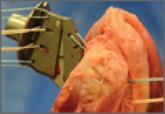Article

Stem-Based Repair of the Subscapularis in Total Shoulder Arthroplasty
- Author:
- Denard PJ
- Lederman E
- Gobezie R
- Hanypsiak BT
Management of the subscapularis is an important component of total shoulder arthroplasty. This technique article describes a stem-specific...
Article
Dislocation and Instability After Arthroscopic Capsular Release for Refractory Frozen Shoulder
- Author:
- Gobezie R
- Pacheco IH
- Petit CJ
- Millett PJ
Abstract not available. Introduction provided instead.
